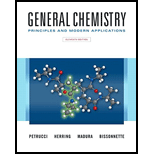
(a)
Interpretation:
The capacitance of the membrane for the typical cell needs to be described.
Concept introduction:
The capacitance can be calculated as follows:
Here,
C − capacitance
e0 − dielectric constant of a vacuum
e0 e− dielectric constant of the membrane
A- Surface area of the membrane
I − membrane thickness
(b)
Interpretation:
The net charge required to maintain the observed membrane potential should be determined.
Concept introduction:
The observed Nernst potential across the cell wall is 0.085 V.
(c)
Interpretation:
Number of K+ ions must flow through the cell membrane to produce the membrane potential should be determined.
Concept introduction:
In most cells K+ concentration inside the cell is greater than the outside. Therefore, there is a stable concentration gradient across the cell membrane. If potassium channels open, K+ starts to diffuse to outside because of concentration gradient. As a result, excess of positive charge on the outside of the cell is built up and inside of the cell become more negative relative to outside. This sets up a electric potential difference across the membrane. This electric potential difference makes the remaining K+ to leave the cell. Finally, the electric potential difference across the membrane achieve a maximum level where the electric force driving K+ back to the cell is equal to the chemical force on K+ towards outside of the cell. At this point there is no net movement of K+.
(d)
Interpretation:
Number of K+ ions in the typical cell should be determined.
Concept introduction:
In most cells K+ concentration inside the cell is greater than the outside. Therefore, there is a stable concentration gradient across the cell membrane. If potassium channels open, K+ starts to diffuse to outside because of concentration gradient. As a result, excess of positive charge on the outside of the cell is built up and inside of the cell become more negative relative to outside. This sets up an electric potential difference across the membrane. This electric potential difference makes the remaining K+ to leave the cell. Finally, the electric potential difference across the membrane achieve a maximum level where the electric force driving K+ back to the cell is equal to the chemical force on K+ towards outside of the cell. At this point there is no net movement of K+.
(e)
Interpretation:
It should be shown that the fraction of the intracellular K+ ions transferred through the cell membrane to produce the membrane potential is so small and it does not change K+ concentration within the cell.
Concept introduction:
In most cells K+ concentration inside the cell is greater than the outside. Therefore, there is a stable concentration gradient across the cell membrane. If potassium channels open, K+ starts to diffuse to outside because of concentration gradient. As a result, excess of positive charge on the outside of the cell is built up and inside of the cell become more negative relative to outside. This sets up an electric potential difference across the membrane. This electric potential difference makes the remaining K+ to leave the cell. Finally, the electric potential difference across the membrane achieve a maximum level where the electric force driving K+ back to the cell is equal to the chemical force on K+ towards outside of the cell. At this point there is no net movement of K+.
Want to see the full answer?
Check out a sample textbook solution
Chapter 19 Solutions
Generl Chem Looself&mod Mst/et&stdy Crd Pkg, 11/e
- Calculate the electrode potentials for the following systems: (a) Cr2O72-(5.00 10-3 M),Cr3+(2.50 10-2 M),H+ (0.100 M)|Pt (b) UO22+(0.100 M),U4+ (0.200 M),H+ (0.600 M)|Ptarrow_forwardWhat is the cell potential of the following cell at 25C? Ni(s)Ni2+(1.0M)Sn2(1.5104M)Sn(s)arrow_forwardFrom the standard potentials Ag2SeO4(s)+2e2Ag(s)+SeO42-E0=0.355V Ag++2eAg(s)E0=0.799V calculate the solubility product constant for Ag2SeO4.arrow_forward
- From the standard potentials Tl++eTl(s)E0=0.336V TlCl(s)+eTl(s)+ClE0=0.557V calculate the solubility product constant for TlCl.arrow_forwardFor each of the following reactions, determine the overall balanced electrochemical reaction, its standard electric potential, and the standard Gibbs energy of the reaction. aCo+F2Co2++2F bZn+Fe2+Zn2++Fe c Zn+Fe3+Zn2++Fe d Hg2++HgHg22+arrow_forwardAt what pH does Ecell = 0.00 V for the reduction of dichromate by iodide ion in acid solution, assuming standard-state concentrations of all species except H+ ion?arrow_forward
 Chemistry: The Molecular ScienceChemistryISBN:9781285199047Author:John W. Moore, Conrad L. StanitskiPublisher:Cengage Learning
Chemistry: The Molecular ScienceChemistryISBN:9781285199047Author:John W. Moore, Conrad L. StanitskiPublisher:Cengage Learning Principles of Instrumental AnalysisChemistryISBN:9781305577213Author:Douglas A. Skoog, F. James Holler, Stanley R. CrouchPublisher:Cengage Learning
Principles of Instrumental AnalysisChemistryISBN:9781305577213Author:Douglas A. Skoog, F. James Holler, Stanley R. CrouchPublisher:Cengage Learning Chemistry: Principles and PracticeChemistryISBN:9780534420123Author:Daniel L. Reger, Scott R. Goode, David W. Ball, Edward MercerPublisher:Cengage Learning
Chemistry: Principles and PracticeChemistryISBN:9780534420123Author:Daniel L. Reger, Scott R. Goode, David W. Ball, Edward MercerPublisher:Cengage Learning Principles of Modern ChemistryChemistryISBN:9781305079113Author:David W. Oxtoby, H. Pat Gillis, Laurie J. ButlerPublisher:Cengage Learning
Principles of Modern ChemistryChemistryISBN:9781305079113Author:David W. Oxtoby, H. Pat Gillis, Laurie J. ButlerPublisher:Cengage Learning Physical ChemistryChemistryISBN:9781133958437Author:Ball, David W. (david Warren), BAER, TomasPublisher:Wadsworth Cengage Learning,
Physical ChemistryChemistryISBN:9781133958437Author:Ball, David W. (david Warren), BAER, TomasPublisher:Wadsworth Cengage Learning,





